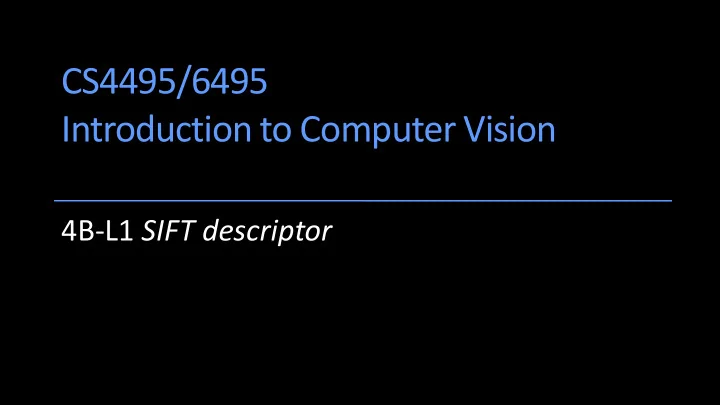

CS4495/6495 Introduction to Computer Vision 4B-L1 SIFT descriptor
Point Descriptors • Last time: How to detect interest points
Harris detector Interest points extracted with Harris (~ 500 points)
Point Descriptors • Now: How to match them? ?
Point Descriptors • We need to describe them – a “ descriptor ” ?
Criteria for Point Descriptors • We want the descriptors to be the (almost) same in both image – invariant. ?
Criteria for Point Descriptors • We also need the descriptors to be distinctive. ?
Simple solution? • Harris gives good detection – and we also know the scale. • Why not just use correlation to check the match of the window around the feature in image 1 with every feature in image 2?
Simple solution? Not so good! • Not so good because: • Correlation is not rotation invariant - why do we want this? • Correlation is sensitive to photometric changes. • Normalized correlation is sensitive to non-linear photometric changes and even slight geometric ones. • Could be slow – check all features against all features
SIFT: Scale Invariant Feature Detection • Motivation: The Harris operator was not invariant to scale and correlation was not invariant to rotation. • For better image matching, Lowe’s goals were: • To develop an interest operator – a detecto r – that is invariant to scale and rotation. • Also: create a descriptor that was robust to the variations corresponding to typical viewing conditions. The descriptor is the most-used part of SIFT.
Idea of SIFT • Image content is represented by a constellation of local features that are invariant to translation, rotation, scale, and other imaging parameters
Idea of SIFT SIFT Features
Another version of the problem… … in here Want to find
Overall SIFT Procedure • Scale-space extrema detection Or use Harris- Laplace or other method • Keypoint localization • Orientation assignment • Keypoint description
Example of keypoint detection (a) 233x189 image (b) 832 DOG extrema
Overall SIFT Procedure 1. Scale-space extrema detection 2. Keypoint localization 3. Orientation assignment Compute best orientation(s) for each keypoint region. 4. Keypoint description Use local image gradients at selected scale and rotation to describe each keypoint region.
Descriptors Invariant to Rotation • Find the dominant direction of gradient – that is the base orientation. Compute image derivatives relative to this orientation
Orientation assignment • Create histogram of local gradient directions at selected scale – 36 bins
Orientation assignment • Assign canonical orientation at peak of smoothed histogram
Orientation assignment • Each keypoint now specifies stable 2D coordinates (x, y, scale, orientation) – invariant to those.
4. Keypoint Descriptors • Next is to compute a descriptor for the local image region about each keypoint that is: • Highly distinctive • As invariant as possible to variations such as changes in viewpoint and illumination
But first… normalization… • Rotate the window to standard orientation • Scale the window size based on the scale at which the point was found.
SIFT vector formation Compute a feature vector based upon: • histograms of gradients
SIFT vector formation Compute a feature vector based upon: • weighted by a centered Gaussian,
SIFT vector formation Compute a feature vector based upon: • weighted by the magnitude of the gradient
SIFT vector formation showing only 2x2 here but it really is 4x4
Ensure smoothness
Reduce effect of illumination • Clip gradient magnitudes to avoid excessive influence of high gradients • after rotation normalization, clamp gradients >0.2
Reduce effect of illumination • 128-dim vector normalized to magnitude 1.0
Evaluating the SIFT descriptors • Database images were subjected to rotation, scaling, affine stretch, brightness and contrast changes, and added noise. • Feature point detectors and descriptors were compared before and after the distortions. • Mostly looking for stability with respect to change.
Sensitivity to parameters
Feature stability to noise
Experimental results - summary Image transformation Location and scale Orientation match match Decrease constrast by 1.2 89.0 % 86.6 % Decrease intensity by 0.2 88.5 % 85.9 % Rotate by 20 ° 85.4 % 81.0 % Scale by 0.7 85.1 % 80.3 % Stretch by 1.2 83.5 % 76.1 % Stretch by 1.5 77.7 % 65.0 % Add 10% pixel noise 90.3 % 88.4 % All previous 78.6 % 71.8 % 20 different images, around 15,000 keys
Experimental results Original image 78% Keypoints on image after rotation (15°), scaling (90%), horizontal stretching (110%), change of brightness (-10%) and contrast (90%), and addition of pixel noise
SIFT matching object pieces (for location)
SIFT matching object pieces (for location)
Recommend
More recommend